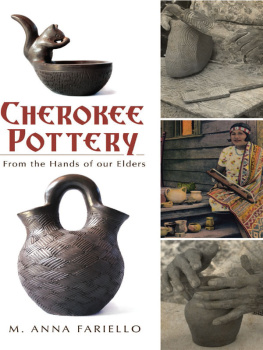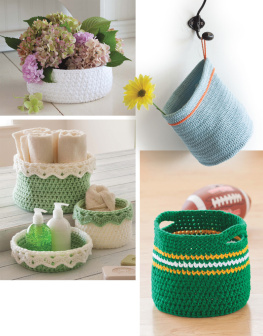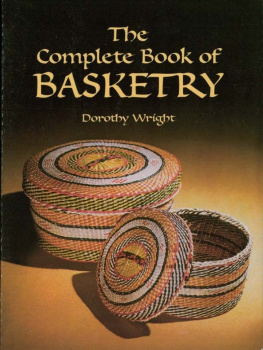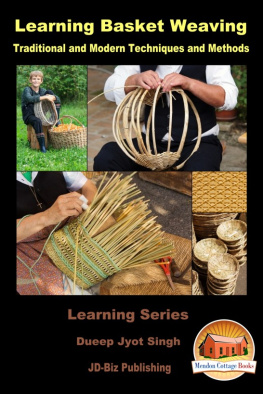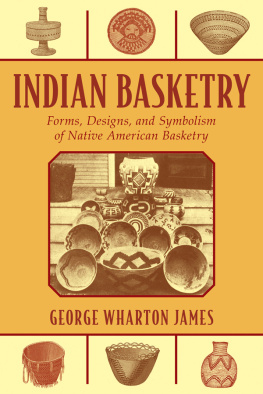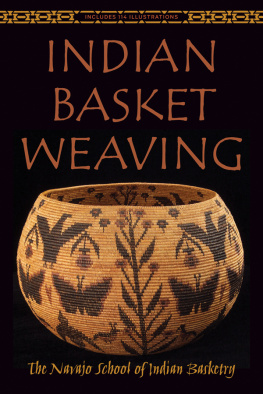C HEROKEE
B ASKETRY
C HEROKEE
B ASKETRY

From the Hands of our Elders

M. Anna Fariello

Published by The History Press
Charleston, SC 29403
www.historypress.net
Copyright 2009 by M. Anna Fariello
All rights reserved
First published 2009
Second printing 2010
ebook edition 2011
ISBN 978.1.61423.002.1
Library of Congress Cataloging-in-Publication Data
Fariello, M. Anna.
Cherokee basketry : from the hands of our elders / Anna Fariello.
p. cm.
Includes bibliographical references.
print edition: ISBN 978-1-59629-721-0
1. Cherokee baskets. 2. Basket making--United States. 3. Cherokee Indians--History.
I. Title.
E99.C5F37 2009
975.00497557--dc22
2009033689
Notice: The information in this book is true and complete to the best of our knowledge. It is offered without guarantee on the part of the author or The History Press. The author and The History Press disclaim all liability in connection with the use of this book.
All rights reserved. No part of this book may be reproduced or transmitted in any form whatsoever without prior written permission from the publisher except in the case of brief quotations embodied in critical articles and reviews.
Contents
Preface
F rom the Hands of our Elders aims to reveal the full and accurate story of Cherokee artisans who lived during the first half of the twentieth century. This book is the first in a series of publications that documents their creative output. While the objective of any research project is a full picture of ones subject, constraints come into play. This project, in particular, was limited by the availability of source material: what is left to see, examine and think about. This opening paragraph is an expression of gratitude to those who documented, photographed and interviewed Cherokee elders during their lifetimes and to those who collected and preserved their work. Without them, this book would not be in your hands now.
Todays effort to document twentieth-century Cherokee basketry is the result of a collaboration among a number of cultural preservation institutions in western North Carolina. The Cherokee Preservation Foundation and Western Carolina University provided funding and support. Qualla Arts and Crafts Mutual, the Museum of the Cherokee Indian and the Hunter Library at Western Carolina University formed the core partnership, each contributing valuable staff time and important historical materials. Particular individuals were generous with their time and expertise. Vicki Cruz of Qualla Arts and Crafts Mutual and James Bo Taylor at the Museum of the Cherokee Indian gave this project their attention and provided guidance throughout. Tonya Carroll assisted with initial basket documentation. Research Assistants Jason Woolf and Kate Carter wrote image captions, checked facts and verified historical sources. Lucas A.A. Rogers photographed the contemporary baskets that appear in this book. Colleagues of Western Carolina Universitys Cherokee Studies programTom Belt, Robert Conley, Andrew Denson, Jane Eastman and Hartwell Francisshared their understanding of Cherokee culture, history and language and ensured that results met academic standards. And finally, this project could not have seen the light of day without the generous spirit of Dean of Library Services Dana Sally and the encouragement of the faculty and staff of the Hunter Library.

Project Assistant Tonya Carroll with baskets in the permanent collection of Qualla Arts and Crafts Mutual.
For the most part, the images reproduced in this publication are from the collections of Qualla Arts and Crafts Mutual and the Museum of the Cherokee Indian. Important regional collections include: Great Smoky Mountains National Park; McClung Museum, University of Tennessee, Knoxville; North Carolina Collection, University of North Carolina at Chapel Hill; Revitalization of Traditional Cherokee Artisan Resources; Southern Highland Craft Guild; and the Special Collections of the Hunter Library. Betty DuPree and Cherokee basket weavers Carol Welch, Elsie Watty and Martha Ross shared personal recollections. Of particular significance is the work of the late Stephen Richmond, who made many of these photographs while he worked for the Department of Interiors Indian Arts and Crafts Board. Others collections include the Library of Congress; Museum of the Red River, Idabel, Oklahoma; National Archives and Records Administration, Special Media Archives Services Division; National Museum of the American Indian, Smithsonian Institution; and the British Museum.
Still, with the efforts and collections of so many, there are challenges in telling this particular story. Circumstance plays a role in its telling. Certainly, there were prolific makers whose stories were not available. These elders join the thousands of unnamed makers who created and maintained traditions during centuries past. To the young people of today, this is the story of your elders, revered makers who practiced a craft much older than they. Where possible, this book uses direct quotations in an attempt to give them voice.
anitsalagi
T HE C HEROKEE
The lands that these Europeans invaded was hardly a New World. Yet even today, there are people who believe that this vast domain called America was nothing but a wild and virgin land just waiting for the advent of the wise and superior Europeans to tame and domesticate it.
Wilma Mankiller, Mankiller: A Chief and Her People
The ancestral homeland of the Cherokeethe Tsalagilay in the mountains of western North Carolina, the valleys of South Carolina and along the river bottoms where east Tennessee meets north Georgia. Their territory once extended to portions of eight modern states. Based on linguistic evidence, most scholars agree that the Cherokee were related to northeastern Iroquois tribes, although there is little consensus as to when the Cherokee first inhabited the southeastern section of the American continent. By the time the first European explorers arrived, the Cherokee shared the southeast territory with the Catawba, Chickasaw and the Creeks. The Choctaw and Chitimacha lived to the south and west. Tsalagi settlements dominated the heart of the region.
Cherokee towns were usually located near creeks where their people had access to an abundance of free-flowing water. Small streams fed into larger ones that, in turn, fed the Little Tennessee, Hiawassee, Savannah and Chattahoochee Rivers. Rivers played an important role in Cherokee life, providing fish for food and navigation by canoe. Water transport was common, and practical, where a mountainous terrain and dense vegetation complicated overland travel. The Cherokee were a settled people who farmed green valleys and hunted abundant wildlife. They hunted deer for meat and used deerskins for clothing and shelter. In the mid-eighteenth century, there were still an incredible number of buffaloes, bears, deer, panthers, wolves, foxes, raccoons, and opossums in the region. Woods buffalo roamed until hunted to extinction.
Next page


